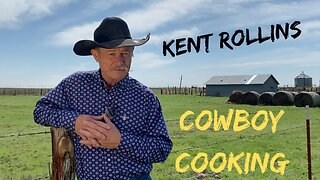Premium Only Content

Stevens Creek Landslide Lake Deposit Layers
Taking a closer look at the sediment layers along Stevens Creek now that the water levels have dropped.
This layering is likely quite complex. After a landslide dams up the creek down stream, water will slowly back up behind that dam. Eventually water will over top the landslide debris and start eroding down, causing the lake to drain. Then, you have the erratic nature of high flows in the creek that are capable of moving large amounts of sediment. As a result, you may have a sediment layer deposited while the water level is rising or when it's falling. The sediment will be deposited at the point the flowing water hits the standing water. Thus, the point of deposition may move up and down the canyon over a single landslide dam event. Add to that, multiple landslides over the milennia, with the creek cutting a new channel in between slides and this is what you get. The key point is that this sediment was likely not deposited in a single event.
You can see how intermittent the flow is in Stevens Creek. In the '21-'22 winter, there were no instances where the flow exceeded 240 CFS, as measured near the inlet to Stevens Creek Reservoir, ~5 miles downstream from here. In the '22-'23 winter, there were 4 times the flow got over 600 CFS., and this was a record rainfall year. On average, there may only be 1 or 2 instances (typically only a few days in duration) per year where there's sufficient flow to transport large amounts of sediment downstream and create one of these layers.
Stevens Creek flow information:
https://alert.valleywater.org/map?p=sensor&sid=5045&disc=f
This is my hypothesis for what has happened in this section of Stevens Creek to explain the flat nature and deep sediment here. Also ties in the anecdotal evidence from the 1973 geology paper.
Paper: ENVIRONMENTAL GEOLOGIC ANALYSIS OF THE MONTEBELLO RIDGE MOUNTAIN STUDY AREA:
https://openlibrary.org/works/OL68916...
Pg. 22 mentions a landslide associated with the 1906 earthquake and this is ground zero for that slide. In fact, the report mentions that slide extended for 1/2 mile, nearly a kilometer, along the canyon.
USGS National Map Viewer w/ Hill Shade layers:
https://apps.nationalmap.gov/viewer/
More to come...
Subscribe for more content like this
Comment, rate, share & click the bell icon
And as always, thanks for watching
#USGS #HillShade #geology #earthquake #tectonicplates
-
 LIVE
LIVE
LFA TV
20 hours agoALL DAY LIVE STREAM 4/21/25
1,132 watching -
 2:12:21
2:12:21
The Quartering
4 hours agoKarmelo Anthony PSYOP, Joe Rogan Attack, Pete Hegseth Stroy , Klaus Schwab Steps Down Pope Dies
124K32 -
 LIVE
LIVE
Dr Disrespect
6 hours ago🔴LIVE - DR DISRESPECT - WARZONE - ATTACK ATTACK ATTACK
2,804 watching -
 30:11
30:11
SantaSurfing
2 hours ago4/20/2025 - Easter Timeline! The old Guard going down! Gold breaks $3400! FREEDOM!
2.78K5 -
 27:08
27:08
Cowboy Kent Rollins
4 days ago $1.44 earnedHistory of a Cowboy Cook | A Day in the Life of a Chuck Wagon Cook
17.6K7 -
 1:28:41
1:28:41
RiftTV/Slightly Offensive
2 hours ago $4.45 earnedAustin Metcalf’s Dad’s EMBARRASSING White Guilt MELTDOWN | The Rift Report
21.4K14 -
 32:40
32:40
The Brett Cooper Show
4 hours ago $5.04 earnedThe Feminist Celebrity Astronauts Who Saved the World | Episode 24
33.4K33 -
 9:38
9:38
Talk Nerdy Sports - The Ultimate Sports Betting Podcast
2 hours ago4/21/25 - Monday Murder: NBA Props, K Kings, and Data-Fueled Chaos
16.3K -
 10:22
10:22
Silver Dragons
3 hours agoIf Gold Price is EXPLODING.. Why is Silver DEAD?
10.4K5 -
 1:35:12
1:35:12
Russell Brand
5 hours agoThe Pope Is Dead—What Happens Now? – SF569
156K83